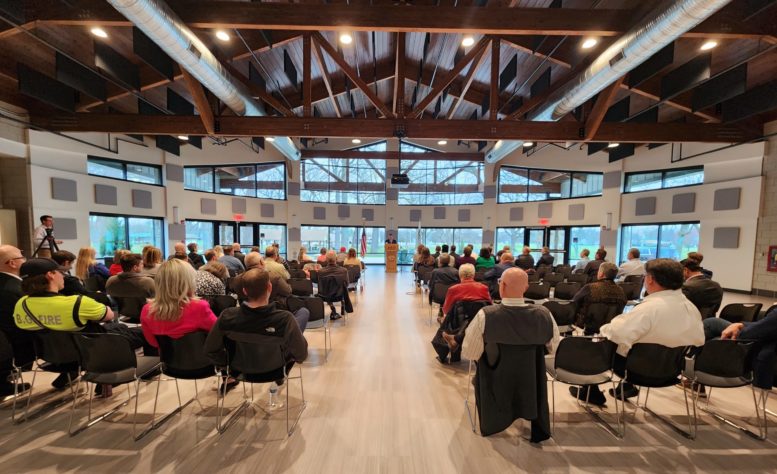By JAN LARSON McLAUGHLIN
BG Independent News
Mayor Mike Aspacher took a trip down memory lane during his State of the City Address Tuesday morning – before making it clear that the good old days make for great memories but not great futures.
He reflected on matinee movies at the Clazel, lunch at the Rogers Drug Store counter, and playing on City Park’s “witch’s wheel” – a piece of metal equipment that could fry an egg and send kids flying in all directions.
While the mayor, who grew up on North Maple Street, has deep and delightful memories of his community, he is not clinging to the way Bowling Green used to be.
Today’s Bowling Green needs to change in order to be better, he said.
And that better Bowling Green includes new school buildings, a new fire station, a revitalized downtown, and a commitment to neighborhoods, he said.
“The reality is that things have changed and the challenge, as I see it, is how we maintain that which is great about Bowling Green, while also understanding and adapting to preferences for 2023 and beyond. What made a vibrant community of 1976 is different from a vibrant community of 2026,” Aspacher said.
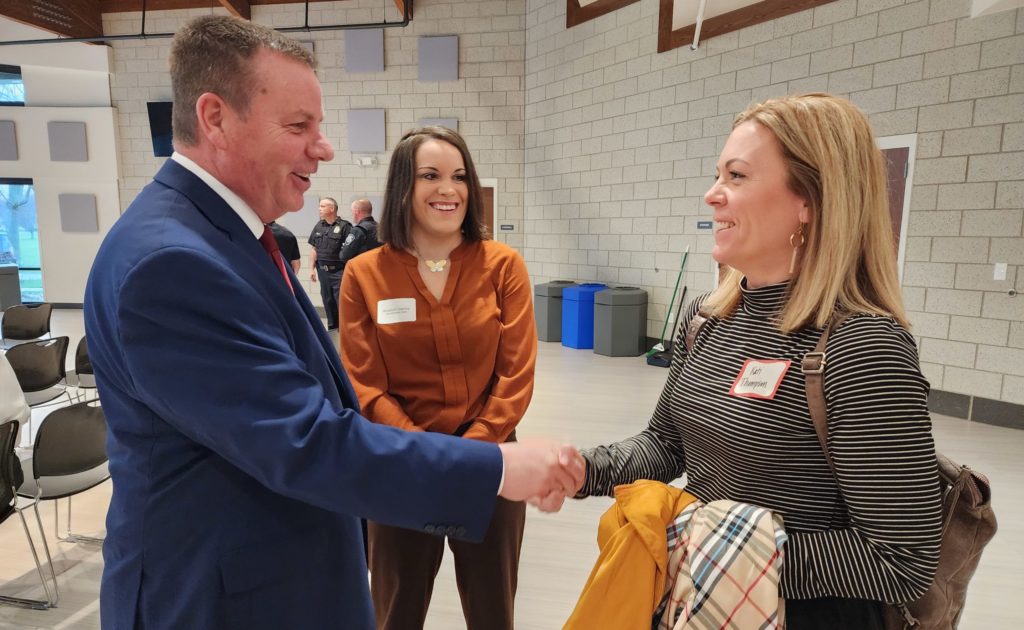
While state of the city addresses traditionally focus on Bowling Green’s past successes and future plans, the mayor made a point of talking about the need for the community to be bold and stand up to support new school facilities – now.
Aspacher attended Bowling Green High School when it still felt new and modern.
Those days are long gone – and the community needs to take action, he said.
“Both my elementary and junior high schools are no longer here and while that is sad for my memories, I was on the school board when those decisions were made. I was proud to be part of building the Middle School and that facility has been a tremendous asset to the community.”
Aspacher stressed that space matters.
“Yes, the quality of teachers matters too, but do not underestimate the environment in which the education is delivered. While new facilities aid the use of technology, they also provide comfort for learning, flexibility for modern education, and creativity to learn in environments that are different from those in which I learned as a child. We can also markedly improve safety in our schools.”
Modern school buildings will positively impact the entire community, he said.
“As the only school district in Wood County that hasn’t updated its facilities, this puts Bowling Green at a disadvantage.”
The investment in school facilities will support the city’s economic development efforts which are focused on attracting new businesses and retaining existing businesses, and will also result in increased property values and expansion of the city’s tax base, Aspacher said.
“Modern, well-equipped school buildings are a factor when people are choosing where to live. Additionally, schools are an important part of a community. Schools are a hub for activities and events. They build community pride. They enhance lives and community both today and tomorrow.”
The mayor acknowledged that conversations about school buildings have been difficult and polarizing in the community.
“I hope, as we go through the next round of discussions, that we can pull together and determine that we as a community need to step up, be bold, be proactive, and make these discussions a reality.”
And now is the time, he said.
“It is critically important that we pass a bond levy in order to begin to invest in our school facilities. This investment will not only result in new and modern school buildings, it will also reaffirm our community to education and make clear our desire to maintain the standard of excellence established by those who came before us. It is our time.”
Aspacher said he looks forward to working with school officials and community advocates this year in an effort to demonstrate the benefit of this investment.
“Bowling Green is fantastic for so many reasons. Let’s make our school facilities another item on that list of assets,” he said.
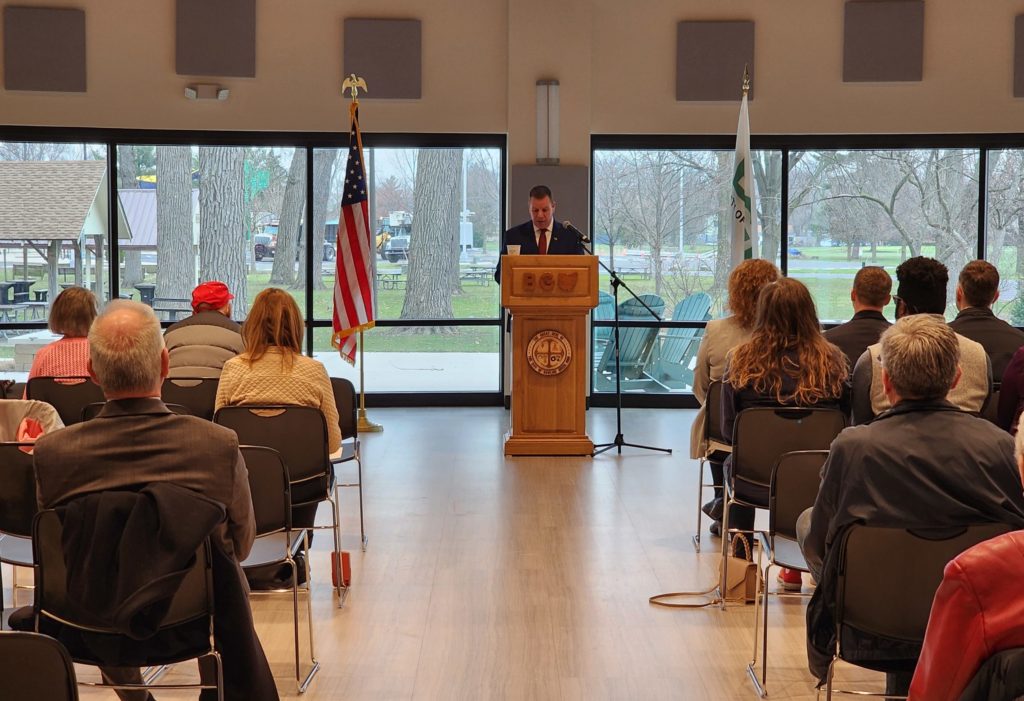
Current city projects
The mayor also talked about city improvements currently underway.
In a few months, city administrative offices will be moving into their new home next door to their current home which they outgrew decades ago.
The facility will benefit the community significantly, the mayor said. The offices most often visited by the public are located on the first floor of the building. The Council Chamber will be able to accommodate larger public meetings. The building meets modern accessibility standards, provides a better work environment for the employees, and includes many sustainable components.
Also ongoing are the infrastructure and roadway projects on Wooster Street. The West Wooster Street project, which includes water and sewer line replacements, demonstrates the city’s ongoing commitment to investing in and upgrading assets, Aspacher said.
The installation of a median and a roundabout at Campbell Hill/East Wooster Street is an example of the city’s long-term planning efforts for traffic safety and aesthetics, he said.
In the downtown area, American Rescue Plan Act funds are paying for the first public restrooms, being built in the Huntington Bank mini-bank by the police station. Those should be completed by summer.
Also ongoing, with the help of ARPA funds, is a residential street paving program. The plan is to pave nearly 11 lane miles of residential streets this year. Another nearly nine miles of roads will be paved this year – including West Wooster to Haskins Road and Haskins Road to the incorporated limits, a section of West Newton Road and a section of North Main near the mall, and the roundabout at East Wooster and Campbell Hill Road.
“That’s a lot of paving, and a lot of orange barrels,” Aspacher said.
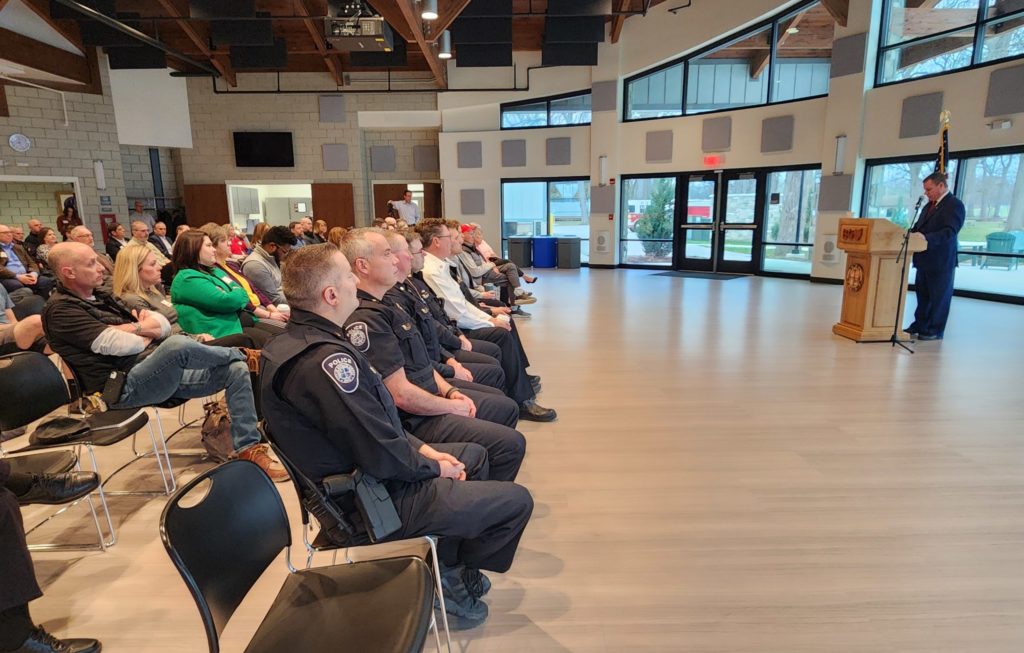
What’s next?
The city is also evaluating other ways to improve the East Wooster corridor, focusing on creating a connection between Thurstin Street and the downtown. But that may mean the moving of two city facilities at the corner of Thurstin/Wooster which house the city electric division and the Court Street fire station.
The fire station is a pressing matter, the mayor said, since it has major structural impediments and environmental concerns. The current station has numerous design deficiencies including the firefighter living space located above the engine room where exhaust permeates into the living quarters.
A study was conducted to identify optimal station locations and, it was recommended that the city consider increasing the number of stations from two to three to optimize response time and in consideration of anticipated community changes.
Also planned is a new police communications center to be built to the south of the police station downtown. The city purchased the former small bank adjacent to the police facility to allow for that expansion.
Aspacher also said the city is working on the best ways to revitalize the historic downtown.
“While we cherish what is here now and must consider how to support, grow, and embrace our current businesses, we must also look openly at what our community wants in this important area and consider changes to encourage its continuing vibrancy,” the mayor said.
An effort, called Downtown Forward, is working to identify priorities and gauge community interest and support.
The city is also looking to build a shared use path to connect Crim Elementary School and Carter Park with a projected cost of $1.7 million. A conceptual design for the project was recently completed.
The city was awarded ODOT safety funding for a different shared use path connecting the Middle/High School campus, the Community Center, and the Cogan’s Crossing subdivision. Aspacher said he is hoping for the same assistance with the Crim-Carter Park pathway.
The mayor also recognized the city’s need to work on several neighborhood issues, many which came to the forefront during recent citizen comments on the proposed zoning code update.
“We have more work to do in this area,” Aspacher said, noting plans for the development of an exterior housing maintenance code.
“This is an important step in efforts to address the quality of housing and neighborhoods in Bowling Green,” he said.
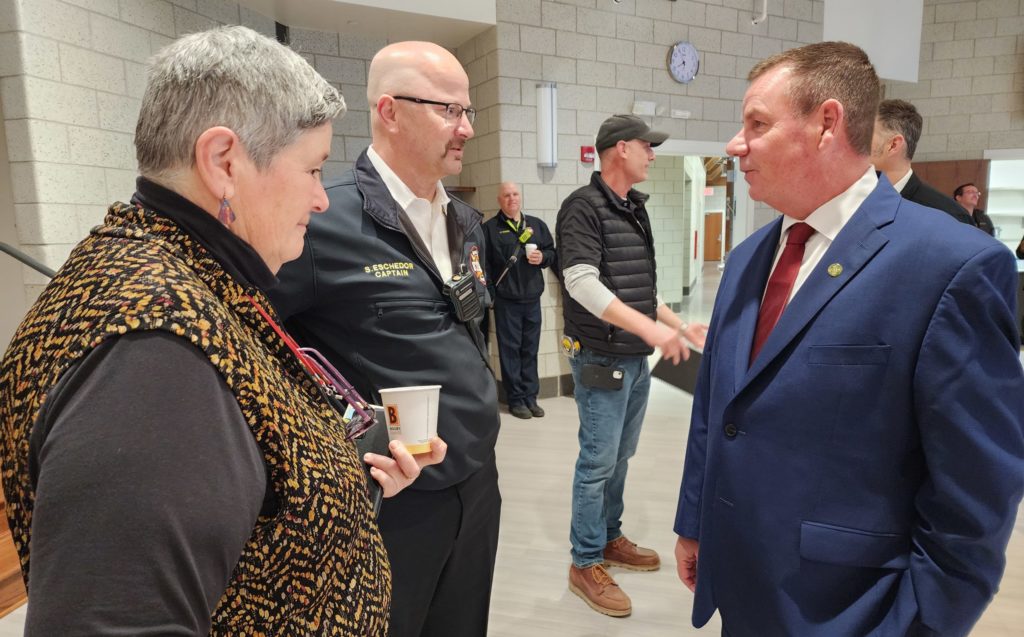
Points of pride
The mayor stressed the importance of the city’s ongoing investments in its public utilities – providing water, wastewater treatment and electric services to residents and businesses.
Improvements at both the water and wastewater plants are ongoing. Though often out of sight of the public, investments in maintenance and technology are critical to continuing operations and reliability, Aspacher said.
“The way that Bowling Green has continually invested in its underground infrastructure is commendable and important,” he said.
“I’m not sure if I should be happy to say that additional investments are on the way or if I should prepare for evasive action before someone throws something at me?” the mayor said with a smile.
Healthy public services help attract economic development to the community, he said.
Those efforts have helped the city secure new facilities from Abbott Laboratories, ICE Industries, Fed Ex, and Vital FHM to the community.
“Bowling Green’s success in the economic development area is a demonstration of the balance of what exists while also accommodating measured and sustainable growth,” Aspacher said.
To support more growth, a second entrance into Woodbridge Business Park, from Wooster Street, will soon be constructed. In addition to the connectivity, a redundant waterline will be built, and additional land will be made available for development.
“This demonstrates our efforts at balance – don’t lose sight of supporting that which is here while also keeping an eye for opportunity,” the mayor said.
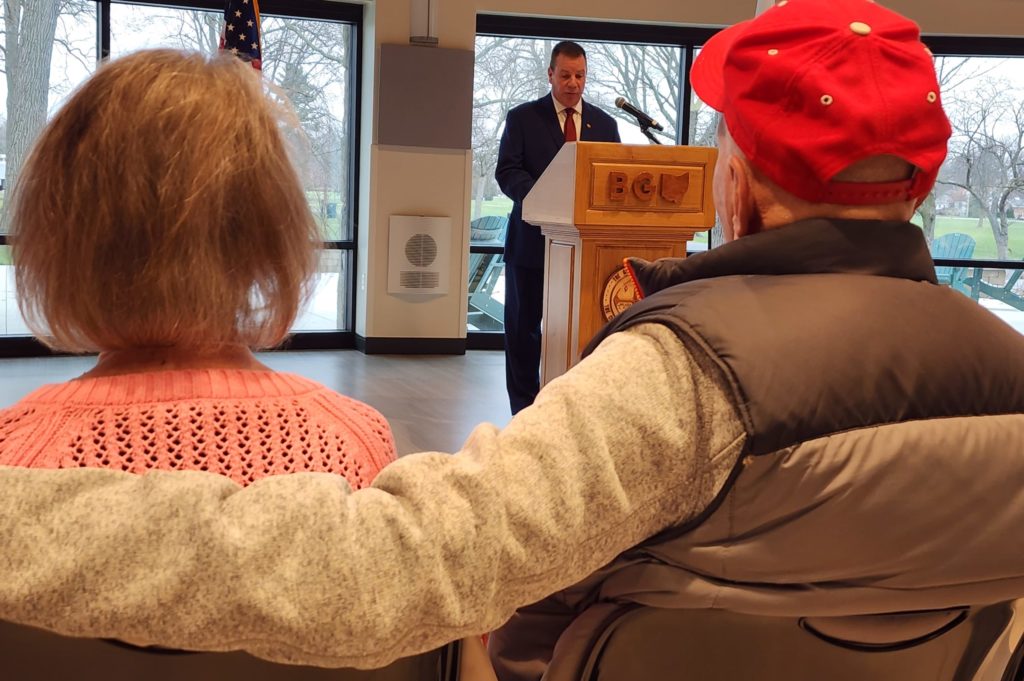
Embracing changes
Aspacher grew up playing kick ball and kick the can on seemingly carefree summer days. His grown sons have fond memories of playing ball at Carter Park, swimming at City Park, and sledding on Conneaut Hill. And his grandchildren love going to city festivals and getting ice cream, heavy on the toppings.
The mayor admitted feelings of apprehension and excitement as city officials contemplate improvements in the town as well as decisions that will impact the years ahead. Bowling Green is a place large enough to offer amenities and opportunities for a wide variety of interests, but small enough that residents are still connected and accessible to each other, he said.
“I believe our town is special,” Aspacher said. “People here care about each other.”
“As our community continues to change with the times as all communities do, I think about how we balance that which makes Bowling Green special today and build on those assets while also encouraging the community to move forward and adapt to the current times.”

